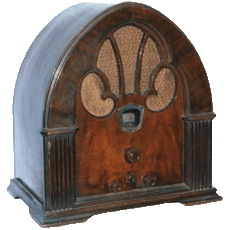Posts: 26
Threads: 8
Joined: Jun 2011
Hi everyone
I purchased a Crosley 10-137 at an estate sale. I recapped electrolytics after turning on and loud hum was heard. Ater that hum gone but no stations could be picked up. Replaced paper caps and finally got stations to come in. However after a minute or two sound started to fade until completly gone. Rechecked tubes and all read in the good range. volume is still there and works but can't recieve any stations. Can anyone tell me where to start to check whats wrong. Cabinet on this is excellant so worth saving.
Thank You
Bob
Posts: 2,128
Threads: 18
Joined: Oct 2008
City: Merrick, Long Island, NY
Well we need to work backwards from the speaker to the antenna, problem's somewhere in between. So if you still have B+ (measure it) and you create a buzz when touching the volume control center with a long test lead with the control all the way up, you know that you have power and amplification. That's half the set!
Then work backward testing voltages for each stage, and bear in mind that a digital meter will read higher, because it does not load down the circuit like old fashioned analog meters. Tons written about this already.
You did not mention whether you checked for out of tolerance resistors (open or more than 20% lower and most likely higher can be a show stopper depending on where in the circuit it is.) For a nickel apiece for most of 'em, I just replace them when doing the cap job.
Then again, you can measure the continuity of the windings of the IF Coils, antenna and oscillator coils, blast out the tube sockets with deoxit, and then attempt a realignment with a signal generator, if you have access to one.
Touch not anything ever when the set is plugged in. Just view your instruments, and be ready to power down quickly.
Well that should get you started.
Posts: 26
Threads: 8
Joined: Jun 2011
Thank you for your response. I did do volume control test and did get a load hum. I was tempted to replace all caps again. But will test resistors first. Do I need to disconect one end to test them?
Posts: 7,298
Threads: 268
Joined: Dec 2009
City: Roslyn Pa
Well that's a good start! Wouldn't replace the caps again that's probably not the problem. We know that the circuits using the 35W4, 12AV or AT6, and 50C5 are working just fine. So we'll need to look at the mixer (12BE6) and IF amp (12BA6). Safety first! When ever working on one of these sets ALWAYS USE A ISOLATION TRANSFORMER! this will isolate the ac line voltage from the chassis. If you like sticking your fingers into a wall outlet don't use one. It will also raise cane with your other test gear if they plug in to the wall.
Now truth be told I don't use one. What you can do is plug the set in turn it on and measure the ac voltage from the chassis to earth ground. Pull the plug turn it around plug it back in check the ac voltage. One way you will have 120vac and the other you will have some static voltage about 20v or so. That's is the way you always want to plug it in(with the static voltage on the chassis) when servicing.
Now for the troubleshooting. You can measure the resistors like Codefox said or you may want to look at some key voltages which may tell you whats going on. So let's go here:http://www.nostalgiaair.org/PagesByModel/173/M0003173.pdf Scroll down to the tube voltage listing. Mostly what you are looking for is the plate and screen voltages on the mixer and IF tubes. Have a look at the voltages and see what you can come up with. To answer your question if there is a part that is in parallel with the resistor yes you must disconnect one end if not you can measure it in the circuit.
Terry
When my pals were reading comic books
I was down in the basement in my dad's
workshop. Perusing his Sam's Photofoacts
Vol 1-50 admiring the old set and trying to
figure out what all those squiggly meant.
Circa 1966
Now I think I've got!
Terry
Posts: 26
Threads: 8
Joined: Jun 2011
Okay Terry I see what you mean by plug turned one way or other it changes voltage path. Now I understand why you never touch chassis!! As soon as i pick up another multimeter. (Old one conked out) I will start testing voltages to that tube. I will leave caps as is for now. THank you both for you help on.
B.J.



![[-] [-]](https://philcoradio.com/phorum/images/bootbb/collapse.png)


